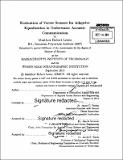Evaluation of vector sensors for adaptive equalization in underwater acoustic communication
Author(s)
Lewis, Matthew Robert, S.M. Massachusetts Institute of Technology
DownloadFull printable version (9.106Mb)
Other Contributors
Woods Hole Oceanographic Institution.
Advisor
James C. Preisig.
Terms of use
Metadata
Show full item recordAbstract
Underwater acoustic communication is an extremely complex field that faces many challenges due to the time-varying nature of the ocean environment. Vector sensors are a proven technology that when utilizing their directional sensing capabilities allows us to minimize the effect of interfering noise sources. A traditional pressure sensor array has been the standard for years but suffers at degraded signal to noise ratios (SNR) and requires maneuvers or a lengthly array aperture to direction find. This thesis explores the effect of utilizing a vector sensor array to steer to the direction of signal arrival and the effect it has on equalization of the signal at degraded SNRs. It was demonstrated that utilizing a single vector sensor we were able steer to the direction of arrival and improve the ability of an equalizer to determine the transmitted signal. This improvement was most prominent when the SNR was degraded to levels of 0 and 10 dB where the performance of the vector sensor outperformed that of the pressure sensor in nearly 100% of cases. Finally, this performance improvement occurred with a savings in computational expense.
Description
Thesis: S.M., Joint Program in Applied Ocean Science and Engineering (Massachusetts Institute of Technology, Department of Mechanical Engineering; and the Woods Hole Oceanographic Institution), 2014. Cataloged from PDF version of thesis. Includes bibliographical references (pages 123-125).
Date issued
2014Department
Joint Program in Applied Ocean Physics and Engineering; Woods Hole Oceanographic Institution; Massachusetts Institute of Technology. Department of Mechanical EngineeringPublisher
Massachusetts Institute of Technology
Keywords
Joint Program in Applied Ocean Science and Engineering., Mechanical Engineering., Woods Hole Oceanographic Institution.